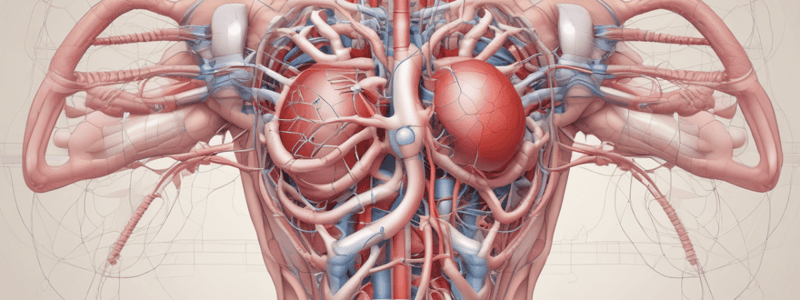Podcast
Questions and Answers
What was the primary purpose of the cardiac catheterization performed on 1000 patients?
What was the primary purpose of the cardiac catheterization performed on 1000 patients?
- To assess the effectiveness of cardiac medications
- To monitor cardiac function during surgery
- To diagnose coronary artery disease
- To prepare patients for peripheral vascular surgery (correct)
How were the patients' coronary arteries classified in the study?
How were the patients' coronary arteries classified in the study?
- Based on the type of peripheral vascular surgery required
- Based on the presence of aortic aneurysms
- Based on the patient's medical history and symptoms
- Based on the severity of CAD and collateral circulation (correct)
What percentage of patients had no suspected CAD?
What percentage of patients had no suspected CAD?
- 21% (correct)
- 14%
- 85%
- 49%
What was the definition of severe, correctable CAD in the study?
What was the definition of severe, correctable CAD in the study?
How many patients had severe, inoperable CAD?
How many patients had severe, inoperable CAD?
What was the name of the journal where the study was published?
What was the name of the journal where the study was published?
What is the primary reason for selecting the radial artery for cannulation?
What is the primary reason for selecting the radial artery for cannulation?
Why is a noninvasive blood pressure cuff placed on the arm contralateral to the arterial catheter?
Why is a noninvasive blood pressure cuff placed on the arm contralateral to the arterial catheter?
What is the primary purpose of a central venous catheter in open aortic procedures?
What is the primary purpose of a central venous catheter in open aortic procedures?
In what patients is the routine use of pulmonary artery catheter monitoring recommended?
In what patients is the routine use of pulmonary artery catheter monitoring recommended?
What is the correlation between CVP and left ventricular filling pressure in patients with good left ventricular and pulmonary function?
What is the correlation between CVP and left ventricular filling pressure in patients with good left ventricular and pulmonary function?
When can invasive monitoring catheters be placed?
When can invasive monitoring catheters be placed?
What is the main advantage of placing a pulmonary artery catheter before induction?
What is the main advantage of placing a pulmonary artery catheter before induction?
In what type of patients may pulmonary artery catheter monitoring be beneficial?
In what type of patients may pulmonary artery catheter monitoring be beneficial?
What has been the outcome of clinical studies on the clinical value of pulmonary artery catheter monitoring in high-risk patients?
What has been the outcome of clinical studies on the clinical value of pulmonary artery catheter monitoring in high-risk patients?
What was the conclusion of the large prospective, randomized trial sponsored by the National Heart, Lung and Blood Institute and the FDA?
What was the conclusion of the large prospective, randomized trial sponsored by the National Heart, Lung and Blood Institute and the FDA?
What is the primary function of transesophageal echocardiography (TEE) during surgery?
What is the primary function of transesophageal echocardiography (TEE) during surgery?
What is the purpose of correcting significant abnormalities in cardiac filling and function before induction?
What is the purpose of correcting significant abnormalities in cardiac filling and function before induction?
What type of aortic dissection requires immediate surgical intervention?
What type of aortic dissection requires immediate surgical intervention?
What percentage of patients with chronic aortic dissection will develop significant aneurysmal dilatation?
What percentage of patients with chronic aortic dissection will develop significant aneurysmal dilatation?
What is the primary reason for early surgical intervention in patients with acute aortic dissection?
What is the primary reason for early surgical intervention in patients with acute aortic dissection?
Which type of aortic dissection has an intimal tear in the proximal descending thoracic aorta?
Which type of aortic dissection has an intimal tear in the proximal descending thoracic aorta?
What is the primary treatment approach for acute dissections involving the descending aorta?
What is the primary treatment approach for acute dissections involving the descending aorta?
Flashcards are hidden until you start studying




